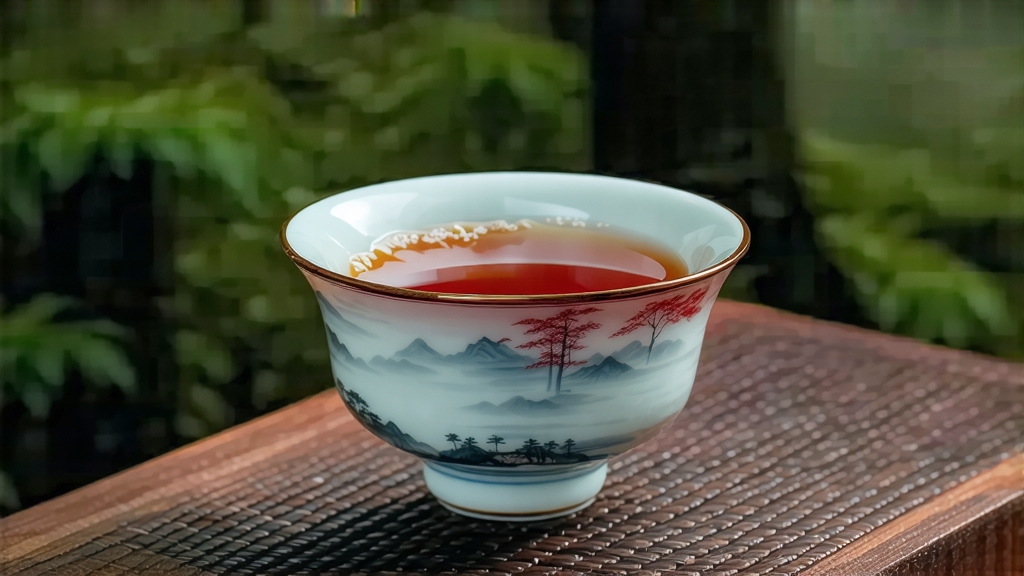
Wuyi Da Hong Pao—literally “Big Red Robe”—is the most mythic name in the oolong universe. Born on the vertiginous basalt cliffs of northern Fujian’s Wuyi Mountains, this tea carries the scent of pine-smoked air, the taste of wet stone after monsoon, and the weight of six centuries of imperial tribute. To understand it is to step into a landscape where myth, geology and craftsmanship intertwine like the twisted trunks of its mother trees.
Legend begins in the Ming dynasty, when a scholar on his way to the capital fell ill at the foot of Tianxin Rock. Monks from Jiulong Ke (Nine-Dragon Cave) brewed leaves picked from four nearby bushes; the scholar revived, passed the imperial exam top of his list, and returned in crimson robes to drape the bushes in gratitude. Whether or not the tale is embroidery, the name stuck, and so did the crimson stigma that still marks the bark of those venerable plants. Today the original “mother trees” are protected by the state; the last harvest was in 2006, and every gram is locked in the Fujian Provincial Vault. What reaches the market are descendants—clones grown from cuttings taken in the 1980s, now spread across 4,000 hectares of the 70-kilometre Wuyi scenic corridor.
Geology is the first secret. The Wuyi range is a UNESCO geopark where volcanic tuff has weathered into a mineral-rich, gravelly soil locals call “rotten rock.” Day-night temperature swings of 15 °C force the tea to thicken its cell walls, concentrating aromatic oils and polyphenols. Constant cloud-fog filters sunlight into a soft, diffused glow, slowing photosynthesis and boosting theanine, the amino acid responsible for umami sweetness. The result is the celebrated “rock rhyme” (yanyun)—a lingering, cooling sensation that Chinese tasters liken to the echo of a bell in an empty valley.
Three sub-categories exist. “Mother-tree Da Hong Pao” is now purely museum stock. “Pure-breed Da Hong Pao” comes from asexually propagated clones (the main cultivars are Qidan, Que-she and Bei-dou) planted in the core 60 km² “zheng yan” (true cliff) zone. “Blended Da Hong Pao” marries leaves from selected Wuyi cultivars—Rou-gui for spice, Shui-xian for orchid depth, Tie-luo-han for minerality—to recreate the mother tree’s profile. A master blender treats the task like composing perfume: base, heart and top notes must harmonize while leaving the unmistakable cliff-stone finish.
Plucking takes place in late April, when three half-mature leaves and a bud form the classic “zhong kai mian” (medium open face). Workers start at dawn to keep leaf temperature below 20 °C, stacking the baskets no deeper than 10 cm to prevent bruising. The first craft step is sun-withering: leaves are spread on bamboo mats for 20–30 minutes, turned every five minutes until the edges feel like soft leather. Indoor withering follows in a screened corridor where mountain breeze lowers moisture to 60 %. Oxidation is triggered by the unique “yao-qing” (shaking-green) motion: 5 kg batches are rhythmically tossed inside a rattan drum rotating at 18 rpm for eight minutes, rested, then tossed again—up to six cycles across four hours. Masters listen rather than watch; the rustle must sound like light rain on banana leaves, signalling the exact 30 % edge browning that defines oolong.
Interruption of oxidation is done with electric woks set at 240 °C, but the leaves are only tumbled for three minutes—just long enough to set the green core while locking in cliff-rock aromatics. Rolling is still done barefoot on a 1.2-metre bamboo tray; the arch of the foot presses without tearing, twisting leaves into the tight “dragonfly head” shape that allows slow, gradual release of flavour. The most iconic step is charcoal roasting. Using local hardwood from the camphor-relative “laurel oak,” craftsmen maintain a low, ash-covered ember at 80 °C for 8–12 hours, repeating the roast two to four times over three months. Between roasts the tea “sleeps”